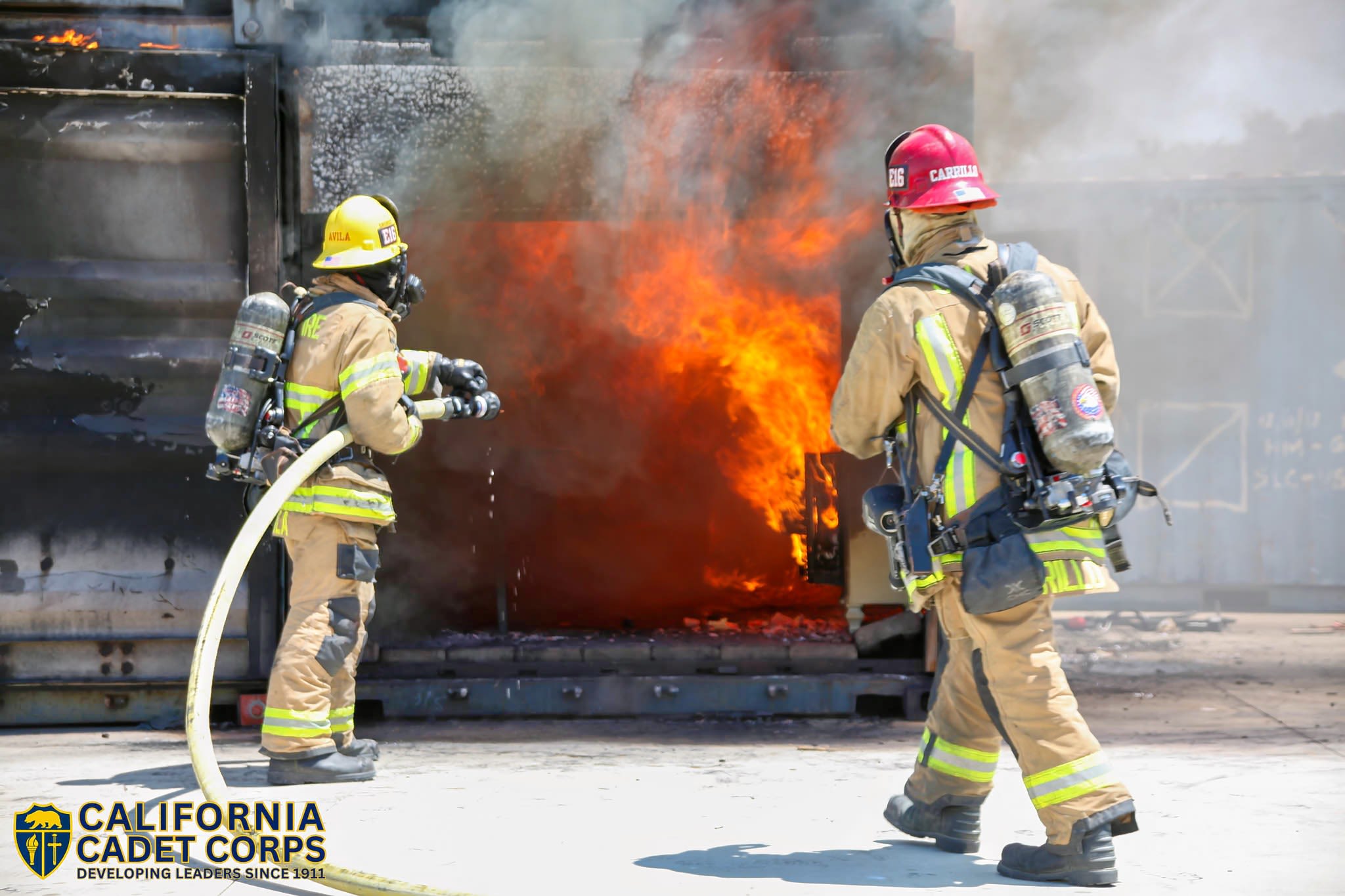FIRED UP
California Cadet Corps Firefighting Unit ignites new opportunities for cadets

By 1st Lt. Jennifer Brofer
California Cadet Corps Public Affairs
June 25, 2025
CAMP SAN LUIS OBISPO, Calif. – For the first time in its history, the California Cadet Corps (CACC) has launched a Firefighting Unit during Summer Encampment June 18-28, offering cadets hands-on emergency response training in partnership with the California Department of Forestry and Fire Protection (CAL FIRE). Eighteen cadets are participating in this dynamic new unit, receiving instruction in wildland and structural firefighting, rope rescue, and fire prevention techniques.
The instruction is led by Warrant Officer 1 Patrick Watson, a fire captain with the Yerington/Mason Valley Fire Protection District in Nevada. With over 20 years in emergency services and eight years in firefighting, Watson brings extensive experience to the classroom and field. His curriculum covers everything from wildland fire behavior and handline construction to interior fire attack and live fire extinguisher practice.
A cadet with the California Cadet Corps Firefighting Unit practices emergency response skills during training at Camp San Luis Obispo, Calif., June 25. The unit, launched in partnership with CAL FIRE, provides cadets with hands-on experience in wildland and structural firefighting techniques.
A cadet with the California Cadet Corps Firefighting Unit practices emergency response skills during training at Camp San Luis Obispo, Calif., June 25. The unit, launched in partnership with CAL FIRE, provides cadets with hands-on experience in wildland and structural firefighting techniques.
“This program prepares cadets to become all-hazards responders,” said Watson. “We’re teaching them to think critically, operate safely, and respond confidently in unpredictable environments—whether it's a structure fire, wildland incident, EMS call, or rope rescue.”
One of the highlights of the week is technical rescue training. Cadets are equipped with Class III harnesses and safely lowered from a three-story training tower using a twin-tension rope system. The training emphasizes safety, situational awareness, and redundant systems to protect cadets during high-angle operations.
Warrant Officer 1 Patrick Watson, lead instructor of the Firefighting Unit during Summer Encampment 2025, brings over 20 years of experience in emergency services and eight years in firefighting.
Warrant Officer 1 Patrick Watson, lead instructor of the Firefighting Unit during Summer Encampment 2025, brings over 20 years of experience in emergency services and eight years in firefighting.
“The safety protocols we teach are no different from what real firefighters follow,” Watson said. “IDLH—Immediate Danger to Life and Health—is a core concept. Cadets learn how to assess risks, use proper gear, and recognize hazards before entering a scene.”
Cadets also engage in wildland drills, donning yellow reflective bunker gear and helmets, practicing shelter deployments, and cutting fire lines with specialized firefighting tools. These tasks simulate real-world wildfire containment strategies. On the structural side, cadets are introduced to heavier protective equipment and SCBA (Self-Contained Breathing Apparatus), underscoring the importance of respiratory safety in fire environments.
Prior to camp, firefighting cadets were required to complete FEMA’s IS-100 and IS-800 courses, along with wildland-specific S-130 and S-190 certifications. These prerequisites lay the foundation for potential future certification as Type 1 firefighters.
Firefighters demonstrate a live burn scenario for cadets in the California Cadet Corps Firefighting Unit at Camp San Luis Obispo, Calif., June 25, The training, conducted in partnership with CAL FIRE, exposes cadets to real-world fire behavior and structural attack techniques as part of the program’s all-hazards emergency response curriculum.
Firefighters demonstrate a live burn scenario for cadets in the California Cadet Corps Firefighting Unit at Camp San Luis Obispo, Calif., June 25, The training, conducted in partnership with CAL FIRE, exposes cadets to real-world fire behavior and structural attack techniques as part of the program’s all-hazards emergency response curriculum.
“This is more than just a training unit,” said Watson. “It’s a stepping stone into careers in firefighting, EMS, forestry, and public safety. We’re giving cadets the tools to protect lives—and shape their futures.”
Cadet Staff Sgt. Isabel Salazar, 434th Battalion, 6th Brigade, joined the Firefighting Unit during Summer Encampment to build self-confidence and explore career paths in public service. “I wanted to challenge myself,” she said. “I never expected to rappel off buildings or create fire lines, but I’ve learned so much. It’s a huge confidence booster.”
Cadet Staff Sgt. Isabel Salazar, 434th Battalion, 6th Brigade, joined the Firefighting Unit during Summer Encampment to build self-confidence and explore career paths in public service. “I wanted to challenge myself,” she said. “I never expected to rappel off buildings or create fire lines, but I’ve learned so much. It’s a huge confidence booster.”
Cadet Staff Sgt. Isabel Salazar, 434th Battalion, 6th Brigade, joined the unit to build self-confidence and explore career paths in public service. “I wanted to challenge myself,” she said. “I never expected to rappel off buildings or create fire lines, but I’ve learned so much. It’s a huge confidence booster.”
Salazar, who is homeschooled through Clarksville Charter School in the Placerville-Folsom area, plans to pursue a part-time role in California’s State Parks system. She credits the Cadet Corps for helping her build leadership, teamwork, and communication skills.
“Being in the Cadet Corps has taught me how to step up and lead,” Salazar said. “Those are skills I’ll carry with me no matter what career I choose.”
Firefighters demonstrate a live burn scenario for cadets in the California Cadet Corps Firefighting Unit at Camp San Luis Obispo, Calif., June 25. The training, conducted in partnership with CAL FIRE, exposes cadets to real-world fire behavior and structural attack techniques as part of the program’s all-hazards emergency response curriculum.
Firefighters demonstrate a live burn scenario for cadets in the California Cadet Corps Firefighting Unit at Camp San Luis Obispo, Calif., June 25. The training, conducted in partnership with CAL FIRE, exposes cadets to real-world fire behavior and structural attack techniques as part of the program’s all-hazards emergency response curriculum.







